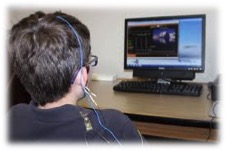The brain is a learning machine
Neurofeedback works by reconnecting functional pathways in the brain through visual and auditory stimulation, which reinforces the brain when operating within normal and optimal ranges.
Neurofeedback changes timing and activation patterns in the brain. This improves brain regulation, which can impact a variety of symptoms – sleep pattern, executive functioning, and emotional regulation.
How is neurofeedback done?
Electrodes are applied to the scalp to capture brainwave activity. The signal is processed by a computer connected with an amplifier, and information is extracted about certain key brainwave frequencies.
The process is non-invasive and painless, no electrical current is applied to the sensors. Information is displayed in the form of a game or image and instruct you on how to make changes using only your brain waves. Some frequencies we wish to promote, and some we wish to diminish.

What results can I expect?
While results may vary based on the severity of your symptoms, research has found that the most typical outcomes from treatment include:
- Reduction of symptoms in general.
- Less suffering.
- Quicker recovery from intense emotional experiences.
- Sharper focus, less distractibility.
- Mental flexibility.
- Everyday tasks become easier.
- Improved quality of sleep.
- Improved emotional regulation.